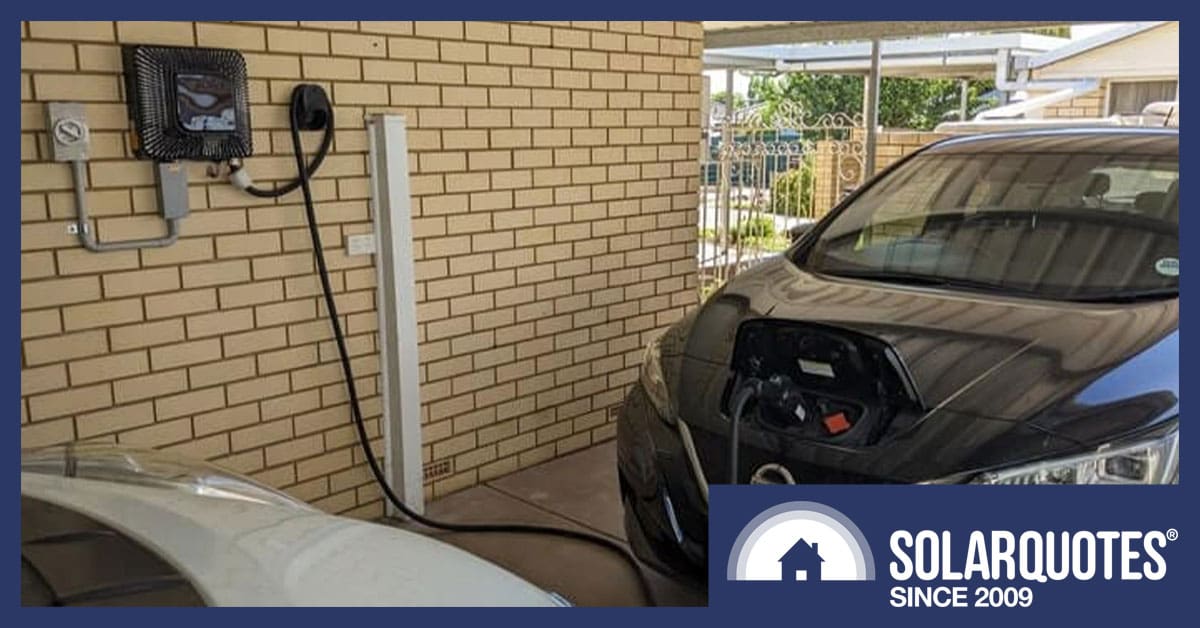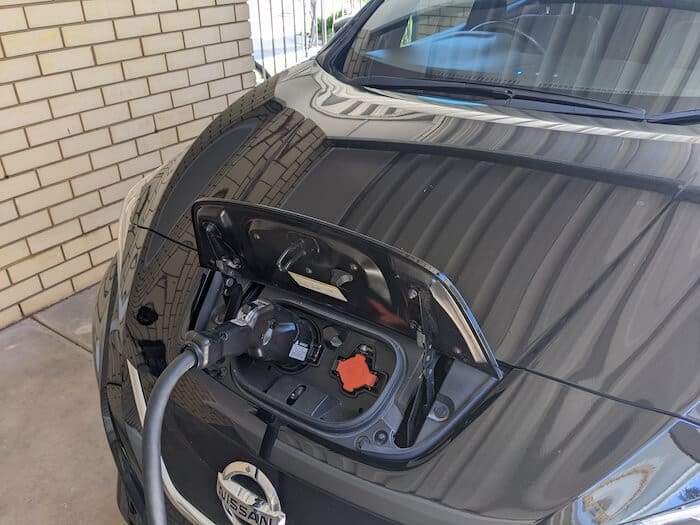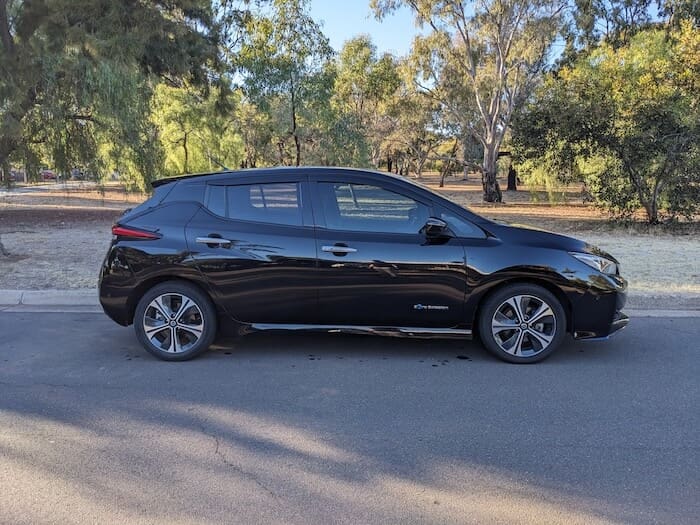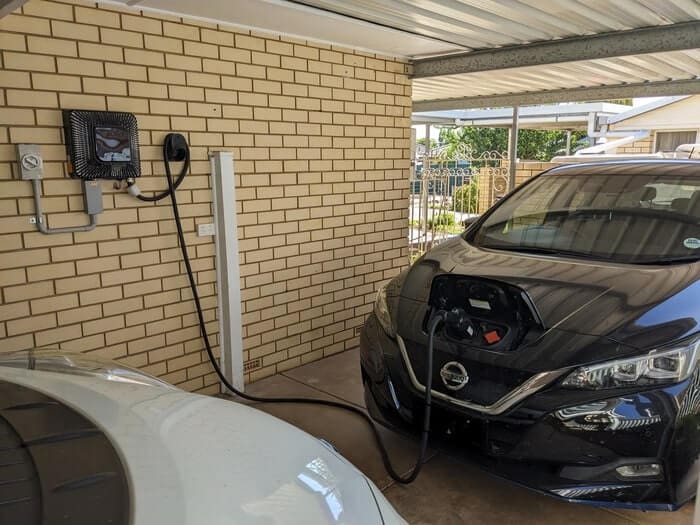Jai Nankivell is one of a handful of Australians with a legally installed home Vehicle to Grid (V2G) installation which works with his V2G compatible electric car to feed electricity back into the grid when it is profitable for Jai to do so.
Before readers get too excited V2G is currently only legal in South Australia, the bi-directional EV charger Jai has isn’t sold anymore (when it did the cost was well over $10000) and hardly any electric cars sold in Australia are V2G compatible.
That said Jai has many interesting insights to offer including how using V2G has improved his health in an unexpected way and maximising V2G profit requires skills similar to a energy markets trader.
— Interview begins:
Imported Nissan Leaf Owner Experience
Neerav: We’re having a chat with Adelaide resident Jai Nankivell about his experience owning a 2018 Nissan Leaf ZE1 e+ (62kWh) and using it with a bi-directional Wallbox Quasar V2G charger.
Jai could you please share, was your electric car bought or leased?
Jai: It was purchased second hand from Good Car Co. The process was very easy but took a while due to Covid delays.
I chose the Japanese version of the Leaf because it has a lane keep assist that the Australian variant doesn’t and optional one-pedal driving which makes driving in heavy traffic easier. Nissan has removed this feature from their latest EV, the Ariya.
I was able to install a Comma 3X (from Comma AI) to upgrade the car to level 2 self driving (hands off, but eyes on and ready to take over at all times). The steering assist is near perfect on the highways. It feels like having cruise control for the first time all over again.
The “self driving” is not quite adequate on back streets yet. It won’t run into any parked cars (it would last year on an older software version), but it still doesn’t navigate unusual situations like roundabouts or single lane roads with an oncoming car.
The Comma is an amazing assist that helps take some stress out of driving. I won’t be buying another car unless it’s compatible with the Comma.
Nissan Leaf ZE1 Frustrations
Neerav: Would you buy or lease this brand of electric car again and recommend it to others?
Jai: No. I would gladly buy another ZE0 Leaf (AKA Gen1: 2012-2015), but never a ZE1 (AKA Gen2) Leaf. No-one should ever buy a ZE1 Leaf unless they already have a CHAdeMO V2G charger and aren’t planning to drive the car.
Don’t buy a new Leaf. The battery overheating is noticeable after about 600km. If you drive on long trips, most new EVs are cheaper and better than a new Leaf. If not, an older Leaf will probably do.
Driving at 90km/h is significantly better for the battery temperature than 110km/h. This is both due to the reduced power requirement while driving, and the reduced energy needed to recharge at each stop.
There is a complete lack of battery cooling (not even a fan for air cooling). The battery overheats if rapid charged 3 times in a day. The third charge of the day is very slow.
I generally seek out the slowest DC chargers on long road trips to reduce battery overheating during charging. I have recently been avoiding EVIE due to their recent $30 precharge policy, and the lack of information on the app while charging.
If there was a company that accepted credit/debit card to start and didn’t require an app, I would exclusively use that company’s chargers. I hate being forced to use an app (RFID card doesn’t count because it still needs to be linked to the app).
Nissan will not touch an imported car, and often won’t touch an electric car they just sold either. No warranty (from Nissan) or any kind of repairs. I have replaced the air-conditioner filter myself.
All of the storage spaces in the new Leaf (ZE1) have been made much smaller than the older (ZE0) Leaf. I found it difficult to find a place to put a small tissue box.
The turning circle is noticeably larger than the ZE0. The handling is significantly worse than the ZE0. The ZE0 handles corners like a racing car, where the ZE1 feels like an SUV.
Front wheel drive means the car is traction limited when accelerating below 80km/h. The traction control system is very conservative, and will limit the torque to well below the traction limit if the wheels slip even slightly. I’m not brave enough to turn off traction control on a public road.
Hitting a small bump while braking will disable regen for a few seconds. This means that a long, steep, slightly bumpy road will cause the car to use friction brakes the entire way down, resulting in hot brakes and no added charge to the battery.
The CHAdeMO port is no longer standard in Australia, and not all rapid chargers have a CHAdeMO cable. Most (all?) new V2G chargers are CCS only, making the Leaf incompatible with V2G. CCS to CHAdeMO adapters are expensive, rare, and don’t work on all EV chargers.
The Japanese imported variant of the Leaf has a Type 1 (J1772) port. Fortunately Type 2 to Type 1 cables and adaptors are available. Cables and adaptors are different, and both are required for full compatibility.
Nissan removed the 80% battery limiter from the Leaf around 2016. This means either faster battery degradation, or having to do maths every time the car is plugged in to work out when to unplug the car to protect the battery.
The Nissan connect app (formerly Car Wings) doesn’t work in Australia, and barely worked in other countries.
The front axle has a click sound when accelerating or braking. This has been a known issue on Nissan vehicles at least 10 years before the Leaf was produced. There is no permanent fix.
Leaf Redeems Itself With V2G
Neerav: How do you regularly charge your car for day to day usage?
Jai: I leave it plugged in to my Wallbox Quasar V2G charger. Charge from solar when available. Charge from the grid if the daytime purchase price is significantly lower than the evening sell price. Run the house and discharge to the grid in the evening, overnight, and during price spikes.
Neerav: Has your investment in V2G technology been worth it?
Jai: V2G has been a game changer when combined with wholesale pricing. I’ve been making around $2-4 per day on an average day, and occasionally over $100 during a price spike (2-3 times per year).
My day to day normal charging experience has been complicated. I’ve been writing my own automations to more accurately control charging and discharging to maximise profit and move as much renewable energy as possible to peak demand times.
I have never had an issue with the car running out of charge because I’ve been powering the house overnight.
The car battery is around 5 times the size of my house battery, and can power the house for close to 2 days of normal use (ignoring any solar produced). In addition, I have a minimum limit set in the charger, so the car will never go completely flat.
I’ve noticed no battery degradation from V2G use, but my example is only anecdotal. A research paper has shown that V2X loads have minimal to no impact on battery life. V2X loads are typically less than 10kW, whereas the battery can be required to output well over 100kW while driving.
It’s disappointing that the company (Wallbox) making the only approved V2G charger decided to stop production of it.
Neerav: Wallbox advises that:
“Wallbox firmly believes that bidirectional charging is key in supporting the transition to a more sustainable use of energy. The market has matured rapidly since the launch of Quasar (1) in 2020. At the moment the industry is seeing a shift towards CCS standards. As Wallbox is committed to offering the market with products that will not only solve problems today, but support the transition to more sustainable energy use long term, Wallbox has made a strategic decision to focus their efforts on Quasar 2, which will offer even greater benefits to users, such as islanding mode“.
V2G Lessons Learnt
Neerav: Do you have any other comments about your V2G experience Jai?
Jai: Since I got the V2G charger I have been cycling a lot more and been healthier. There is now a downside to not leaving the car plugged in at home, so I’ve been realising that I don’t actually need to drive for most trips.
Neerav: Jai makes a great point here which may seem obvious but to make the most of V2G your EV has to be plugged into your house a lot of the day and night.
Just plugging your EV into your house via V2G overnight will help your electricity bill a bit but for maximum impact the car needs to be plugged during the day as well to soak up excess solar generation.
— Interview ends:
Related: Finn has also previously written about the first bi-directional charger install on a residential or commercial property in Australia at Ballycroft Wines located in the Barossa Valley region of South Australia. Find out more on bi-directional charging on our dedicated V2L, V2H & V2G page.





 RSS - Posts
RSS - Posts



So, basically V2G is not worth having on your car, as you cant drive it anywhere…
Not at all – think about the logistics of it – you drive to work and get to charge for free from the big solar array your boss has on his roof to attract the best employees. You then drive home, plug in during peak times, and your car starts feeding the house so you are not paying exorbitant Peak hour/demand charges.
You take your 2nd ev to work the next day whilst your other car remains at home and can top up from solar during the day
I know this would be the perfect scenario for us (we both WFH) but both of our kids drive are are desperate to buy a cheap electric car to get free charging and get away from electricity bills
You absolutely can drive it anywhere. When I actually need the car, I unplug it, drive it as normal, and just put up with paying a normal amount for electricity that day.
On days when I don’t need the car, I can save a lot or even make money by leaving it at home. There is no downside.
Probably, but V2H can somewhat reduce the battery investment required for off-grid – or extend operation without needing to start the generator. (I haven’t had to resort to either yet, through autumn and winter, but that’s due to a large battery and matching consumption to solar generation – 25 kWh today, half into the EV, now at 100%. )
…. not so! It could come in handy at times being able to move your battery fitted with wheels!
To the contrary in the case of a prolonged power outage you can use your V2G enabled EV to fetch extra electricity for your home from the nearest operating public charger, or store from an islanded solar setup.
Also a Leaf with moderate battery degradation still has at least equivalent storage capacity to a decent home battery at a fraction of the capex. Happy to park our Leaf up and use the Polestar2 if the situation requires. Waiting for V2G to be a thing here in NZ.
So just when will the rest of us plebs be able to use V2G?
Its a chicken and egg thing – the manufacturers are waiting for the final version of the CCS2 bi directional standard to be announced (which should be just a software update for newer cars) (2023 onwards) and once the standard is finalised then hopefully the Fed Govt will get involved to mandate it – rather than waiting on each of the DNSPs to get their fingers out and test it etc
Once that happens then we will see overseas vendors submitting their units for testing
Craig
The Quasar was given a provisional approval before a general approval had been finished.
We’re currently waiting on:
CCS V2G standards to be finalised,
V2G grid codes to be finalised and approved,
Housing electrical standards to be approved,
At least 1 charger to be made that implements all the standards,
At least 1 car that can correctly interface with a CCS V2G charger.
This has been in progress for quite a while, and there are a lot of people doing their best to make it happen. With any luck, the first chargers should be available within a year, possibly up to 2 years.
I’m considering a Leaf here in Canada. Probably overheating won’t be a problem. Wr had snow and frost warnings day before yesterday, and tomorrow’s the summer solstice.
My enthusiasm for V2G had beem recharged by the article, but at $10,000 for the charger and needing the car home so much I’d wonder why not jusy get a short range PHRV and a large house battdry?
Hi Randy, My wife, Lynne and I drive a 2018 GM BoltEV. We moved to Mississauga in 1972, and are in the process of returning (after 50+ years) home to Adelaide. We are doing the 50/50 endless summer October to April 5074, and L5H2E4 April to October. Our fourth move trip this October I am planing to purchase a BYD Seal in Adelaide. Don’t know if you are on the West or East side of Canada, but would like to exchange ideas if possible? We have PV on our roof at 5074 13.3 Kw for $8.9K, just got a quote for ontario at $30K for 10 kw. My email is rob-at-syn.ca if you would like to get in touch.
In my view, V2G is a really silly idea, makes little sense economically and technically. V2H is a different story and that would be useful if it can do the same job as a fixed home battery. A 30 to 50kWh capacity battery in a car would easily run most homes overnight without impacting the cycle count too much. I would imagine most EV owners would jump on that.
As someone who lives off grid I cant wait for someone to produce a v2h vehicle with a 70kwh battery bank that can run my house. The cost of a car with 70kwh battery is less than the cost of a home battery of the same size and you get the added advantage of being able to drive it somewhere and charge it up if you get an extended period of dull weather. Current vtL cars can only supply 3.6kw which is not really sufficient for a large household so I patiently wait for someone to produce a v2h vehicle with at least 5kw capacity.
10kW output for V2H would give some headroom.
15kW would solve it for 99.5% of residential users I presume and if everyone had this bye bye solar duck curve.
V2G not required, just charge more for evening loads once V2H is approved and only for those that have a car charger at home. $ will change the behaviour
Chris & Dan,
Anyone viably off-grid has a more-or-less substantial domestic battery, so 10 – 15 kW of V2H doesn’t seem to be needed? My MG4’s 50 kWh would be exhausted in half a night at the lower figure. It only does 2.5 kW or so of V2H, but that could continuously charge the domestic battery, which then drives the 10 kW peak loads at up to 25% duty cycle, without losing SoC.
But with 46 kWh of domestic battery, and modest loads, I tend to go the other way, hammering a hefty charge into the car during the day, even at the cost of transient dips in house SoC during overcast. (The MG4 is giving me a limited 300 km or so of highway driving, and I’ve just bought a trailer, which can halve that. I haven’t figured out any of that fast charger app stuff, so home base is _it_ for range.)
So long as the HWS is on a power diverter, it can’t drain the battery. And if hot water use exceeds production in days of rain clouds, then cold showers are shorter anyway, saving water.
Overnight heating is not required here in Gippsland, in a 6 star home, and a wood fired heater is ample on cloudy days. (Firewood chunks are congealed sunlight – single-use thermal solar batteries.)
We put down a deposit on a new Mitsubishi Outlander Hybrid that has a battery that can be used in this way , and we waited 15 months before any delivery was expected . During that time we investigated the Wallbox . We live in Shepparton with masses of good sunlight for the solar panels on our roof.. Despite all efforts we could get nothing . We had a major electrical company Watters doing some research too . All to no avail . After a couple of price increases before any delivery , we finally cancelled our order at no cost . We have stuck with our diesel dinosaur Pajero . I’d still buy a suitable car if the V2H or V2G devices could be purchased . Until then we’ll look to installing a battery but hope the future is a car that can send power to the grid or house , we can use to power our camping trips and be economical on longer trips
Hi Paul,
Get yourself an EV (or PHEV?) with an onboard inverter that offers V2L… then get this ; https://www.solarquotes.com.au/blog/hoem-review/
As I understand it (after email from manufacturers yesterday) the Wallbox Quasar 2 will first go to North America with V2G and Europe/Rest of World sometime after when they get around to it.
Using the word “rubbish” to describe the Nissan ZE1 is rather harsh, just because it doesn’t suit you. After 4 years, we’re still very happy with our UK built ZE1, and none of the complaints you list affect us; in particular, battery heating isn’t a problem in Tasmania. The choice of any car is very personal (horses for courses) and one person’s “rubbish” is another one’s preference.
With retailers offering Midnight to 6am 8c/kwh, 11am-2pm free electricity..a 2 EV household with solar sounds like the dream for a family household.
During the day, car1 (drop off/pickup), supplies the house (and scabs the free electricity in the free window).
During the night, car1 recharges and the 2nd EV supplies.
Rotate in the morning. Seems very doable. Where the hell is V2H tech? (And Elon needs to decouple the powerwall & solar excess charging)
The ZE1 is perfectly fine if you drive less than 150km per day like most people. It helps to have a second car for long trips.
Saying that nobody should buy one at all ever is a bit naive. Just because you can’t figure out what it was made for doesn’t mean other people won’t. It’s an excellent town car. Plenty of torque to get ahead of traffic though it does feel heavy on the bends. The ride is nice. Test drive one and you might be pleasantly surprised. Costs nothing to run and has over 200km range which will navigate any city all day, especially in start stop traffic due to regen braking. It is not made to spend hours at 110km/h, so use something else for that. Simple as that.
Thanks for driving the price down though… I bought one with 50,000km for $22k out of Japan a few months ago. It presents as near new. It’ll pay for itself in fuel savings after 4 to 5 years. Free car can’t recommend enough. It should not have been that cheap. Jap exporters are out of their minds or our importers are lazy. One way or another prices like that won’t last. Was the best thing to come across my desk in a while lol.
I’m an example of someone for whom V2G is ideal.
I’m retired and work two days a week. For the other five days generally the car is back home for at least half the day. For me having an EV is just as much if not more about V2G than it is about transport – two days a week and at odd other times I use it for transport while at home it’s available for V2G all other times.